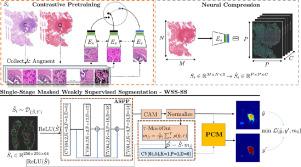Medical Image Analysis ( IF 10.7 ) Pub Date : 2022-05-25 , DOI: 10.1016/j.media.2022.102482 Philip Chikontwe 1 , Hyun Jung Sung 2 , Jaehoon Jeong 1 , Meejeong Kim 2 , Heounjeong Go 3 , Soo Jeong Nam 2 , Sang Hyun Park 1

|
In digital pathology, segmentation is a fundamental task for the diagnosis and treatment of diseases. Existing fully supervised methods often require accurate pixel-level annotations that are both time-consuming and laborious to generate. Typical approaches first pre-process histology images into patches to meet memory constraints and later perform stitching for segmentation; at times leading to lower performance given the lack of global context. Since image level labels are cheaper to acquire, weakly supervised learning is a more practical alternative for training segmentation algorithms. In this work, we present a weakly supervised framework for histopathology segmentation using only image-level labels by refining class activation maps (CAM) with self-supervision. First, we compress gigapixel histology images with an unsupervised contrastive learning technique to retain high-level spatial context. Second, a network is trained on the compressed images to jointly predict image-labels and refine the initial CAMs via self-supervised losses. In particular, we achieve refinement via a pixel correlation module (PCM) that leverages self-attention between the initial CAM and the input to encourage fine-grained activations. Also, we introduce a feature masking technique that performs spatial dropout on the compressed input to suppress low confidence predictions. To effectively train our model, we propose a loss function that includes a classification objective with image-labels, self-supervised regularization and entropy minimization between the CAM predictions. Experimental results on two curated datasets show that our approach is comparable to fully-supervised methods and can outperform existing state-of-the-art patch-based methods. https://github.com/PhilipChicco/wsshisto
中文翻译:

具有自等变正则化的神经压缩组织病理学的弱监督分割
在数字病理学中,分割是疾病诊断和治疗的一项基本任务。现有的完全监督方法通常需要准确的像素级注释,而生成这些注释既费时又费力。典型的方法首先将组织学图像预处理成补丁以满足内存限制,然后执行拼接以进行分割;由于缺乏全球背景,有时会导致性能下降。由于图像级标签的获取成本更低,因此弱监督学习是训练分割算法的更实用的替代方案。在这项工作中,我们提出了一个弱监督的组织病理学分割框架,仅使用图像级标签,通过自我监督改进类激活图 (CAM)。第一的,我们使用无监督对比学习技术压缩千兆像素组织学图像,以保留高级空间上下文。其次,对压缩图像进行网络训练,以联合预测图像标签并通过自监督损失优化初始 CAM。特别是,我们通过像素相关模块 (PCM) 实现细化,该模块利用初始 CAM 和输入之间的自注意力来鼓励细粒度的激活。此外,我们引入了一种特征掩蔽技术,该技术在压缩输入上执行空间 dropout,以抑制低置信度预测。为了有效地训练我们的模型,我们提出了一个损失函数,其中包括一个带有图像标签的分类目标、自监督正则化和 CAM 预测之间的熵最小化。两个精选数据集的实验结果表明,我们的方法与完全监督的方法相当,并且可以胜过现有的最先进的基于补丁的方法。https://github.com/PhilipChicco/wsshisto











































 京公网安备 11010802027423号
京公网安备 11010802027423号